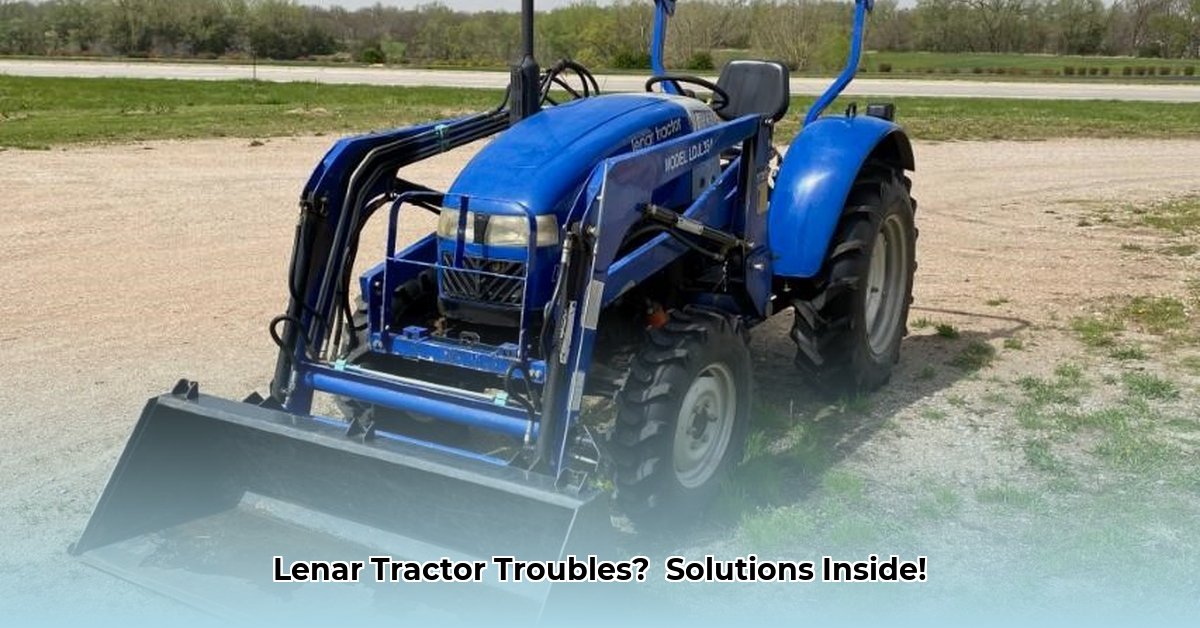
Buying a tractor should be an exciting investment, not a recipe for disaster. However, for many farmers, the allure of low-cost equipment like the Lenar tractor has proven disastrous, highlighting a critical problem in the agricultural equipment market: the failure of budget-friendly options to deliver on their promises of affordability due to reliability issues and a lack of adequate support. For more information on the Lenar tractor issues, see this case study. This case study, based on the experiences of farmers like Patrick Webb, will analyze the Lenar tractor's failure, explore its root causes, and provide actionable recommendations to help you make informed decisions about agricultural equipment purchases. This isn't just about fixing a broken tractor; it's about ensuring your farm's long-term success.
The Patrick Webb Story: A Cautionary Tale
Patrick Webb, a sustainable farmer from Iowa, purchased a Lenar tractor hoping to save money. His experience quickly turned into a costly nightmare. "Within weeks," Webb recalls, "the engine started knocking, hydraulic hoses burst, and the four-wheel-drive system sputtered. It was a constant battle with breakdowns." This wasn't an isolated incident; numerous online forums are filled with similar stories of Lenar tractor failures. Webb's situation exemplifies a larger issue: the gap between the promise of affordable equipment and the harsh reality of frequent repairs and inadequate dealer support. Isn't it crucial to consider the true cost of ownership before making such a significant investment?
Repeated Mechanical Failures
The recurring mechanical failures experienced by Webb and other Lenar owners highlight a major problem stemming from inconsistent manufacturing practices. Reports suggest Lenar sourced components from various Chinese manufacturers such as Jiangling and Dongfeng, resulting in inconsistent quality control and widespread problems with the engines, transmissions, and hydraulic systems.
Inadequate Warranty Support
Webb's warranty proved virtually useless. "Lenar's customer service was nonexistent," he stated. The promised support network evaporated, leaving him to shoulder the entire cost of repairs. This underscores a critical risk in purchasing lower cost equipment from a newer, less established company, lacking a reliable infrastructure.
Dealer Network Collapse
The collapse of the Lenar dealer network compounded the problem. When the local dealer closed, Webb was left scrambling for parts and competent repair services. The lack of readily available support and parts created significant downtime, impacting productivity and profitability. This situation emphasizes the importance of fully vetting the dealer and the extent of their support network beforehand.
Analyzing the Root Causes: A Systemic Issue
The Lenar tractor's failure is not just a matter of bad luck; it points to significant flaws within the agricultural equipment supply chain. The key vulnerabilities are:
- Inconsistent Manufacturing: The practice of sourcing components from multiple manufacturers resulted in inconsistent quality control and unreliable equipment.
- Fragmented Dealer Network: The lack of a robust dealer network left farmers with limited access to timely repairs and parts.
- Unreliable Warranties: Warranties proved difficult, if not impossible, to utilize, leaving farmers responsible for significant repair costs.
- Parts Shortages: Farmers faced delays and difficulty sourcing replacement parts, resulting in prolonged downtime.
This combination creates a high-risk scenario for farmers, negating any initial cost savings through extensive repair bills and productivity losses.
Actionable Recommendations: Protecting Your Investment
To avoid the pitfalls encountered by Webb and others, consider these crucial steps:
- Conduct Thorough Research: Before purchasing any major piece of equipment, meticulously research the manufacturer's reputation, warranty terms, and the dealer support network. Check online reviews and forums for real-world experiences.
- Visit Dealers In-Person: Schedule a site visit to the dealer to assess their facilities, staff expertise, and overall reputation.
- Calculate the Total Cost of Ownership (TCO): Don't just focus on the initial purchase price; estimate all potential costs, including maintenance, potential repairs, fuel, and downtime.
- Explore Leasing Options: Consider leasing as an alternative to purchasing, which can spread costs over time and mitigate risks associated with unreliable equipment.
- Build a Strong Support Network: Develop relationships with knowledgeable mechanics and parts suppliers in your area to ensure prompt service and support.
Conclusion: Building a More Sustainable Future for Farming
The Lenar tractor case highlights a critical need for greater transparency and accountability within the agricultural equipment industry. Farmers, manufacturers, and policymakers all need to prioritize quality control, robust dealer networks, and reliable warranties to ensure farmers have access to reliable and affordable equipment. The long-term sustainability of farming depends on it. Prioritizing the total cost of ownership – considering not just initial price but also maintenance, repairs, and downtime costs – is crucial for informed decision-making. This goes beyond individual farm decisions and underscores the need for stronger regulations and increased oversight within the sector.